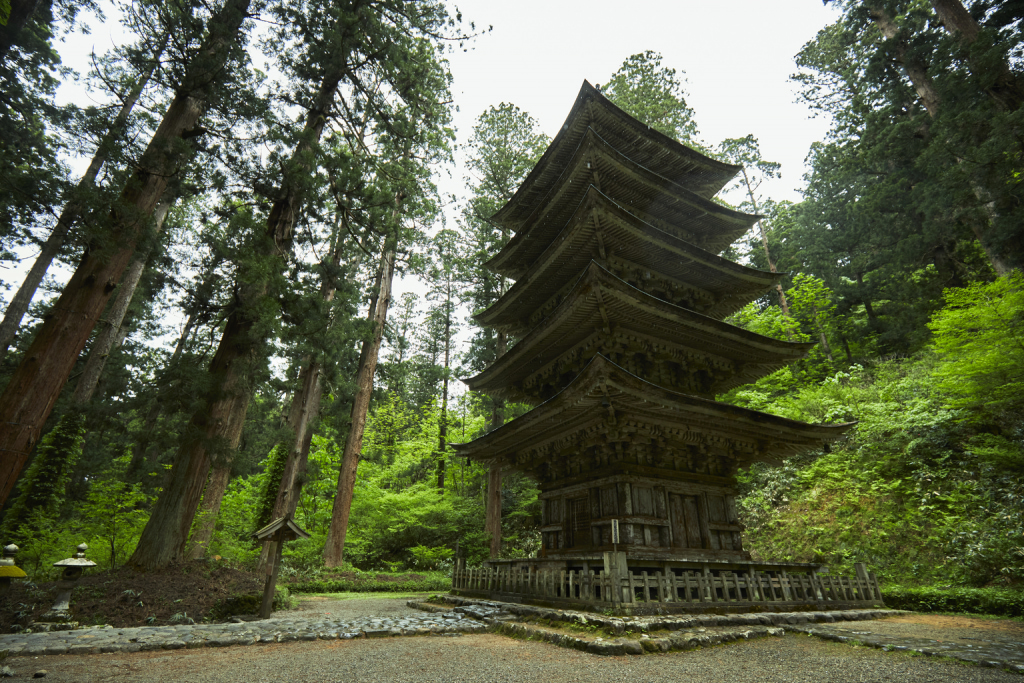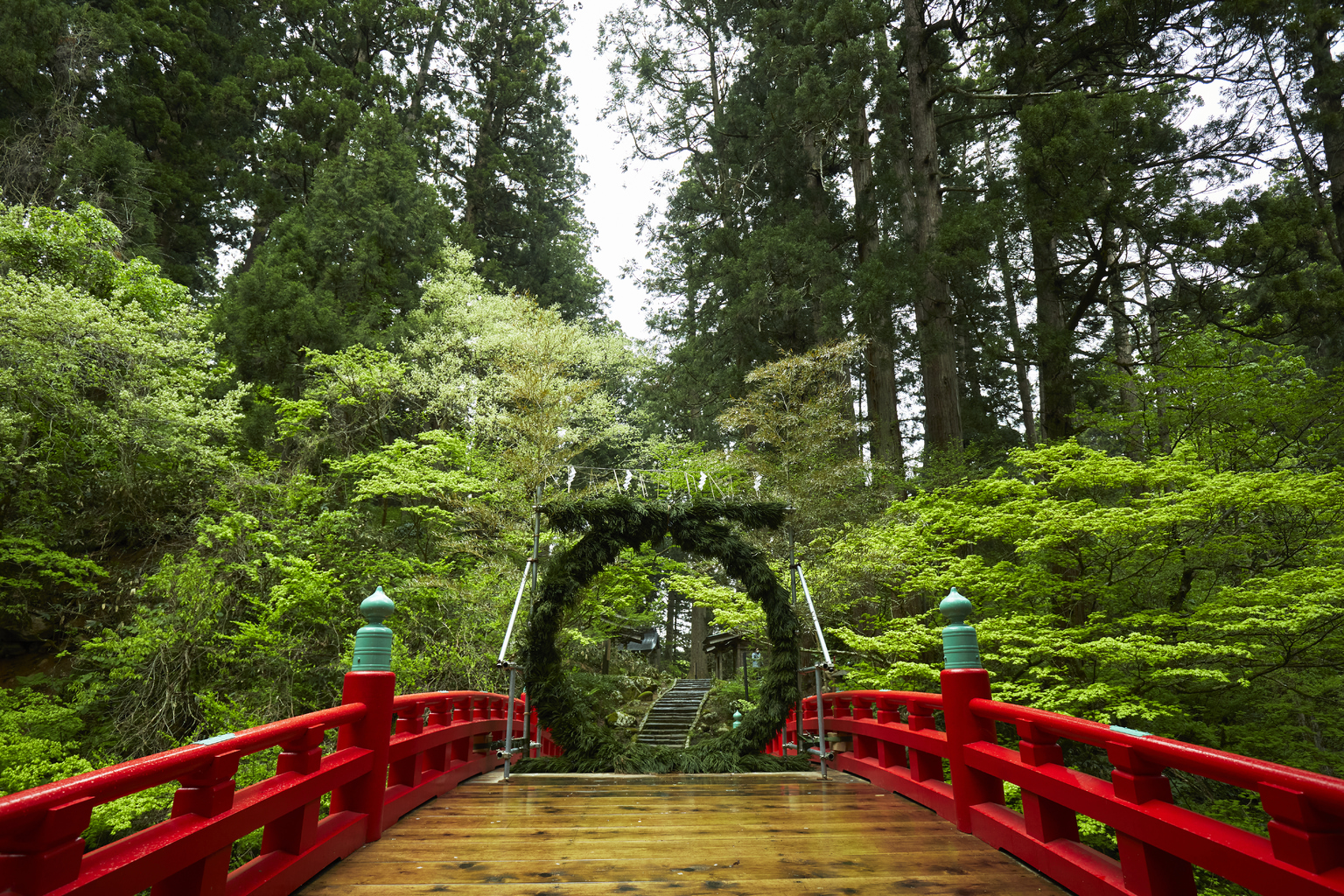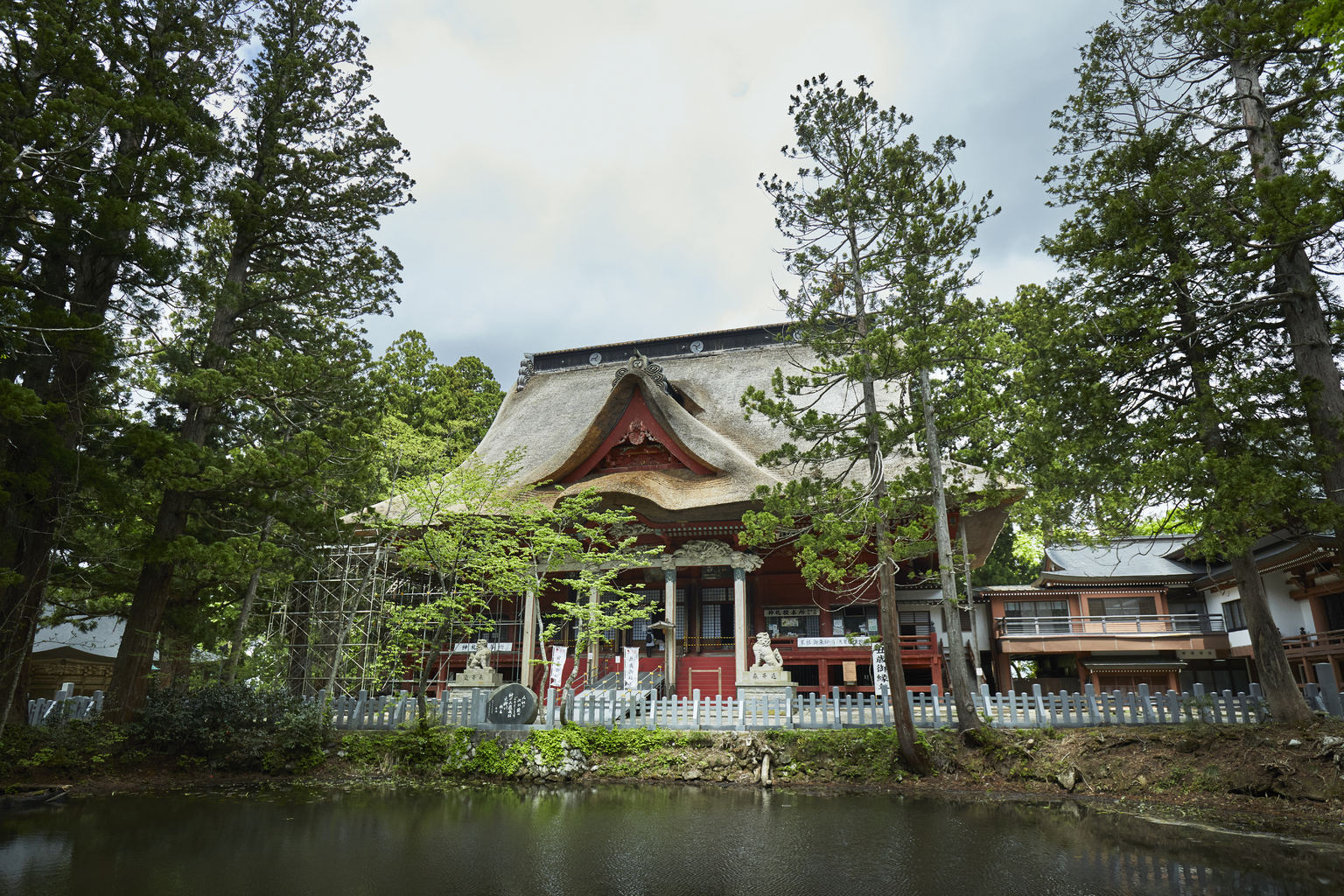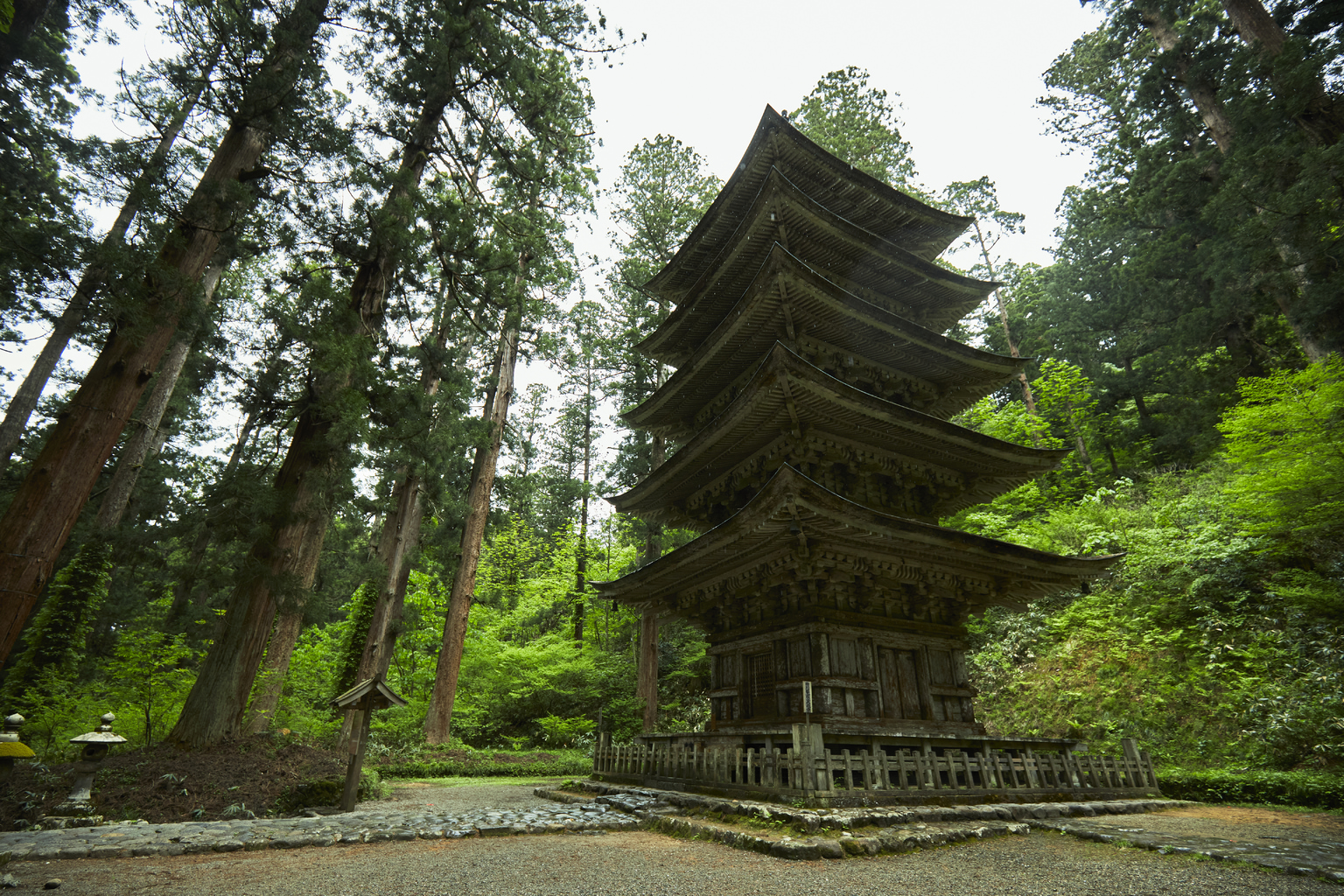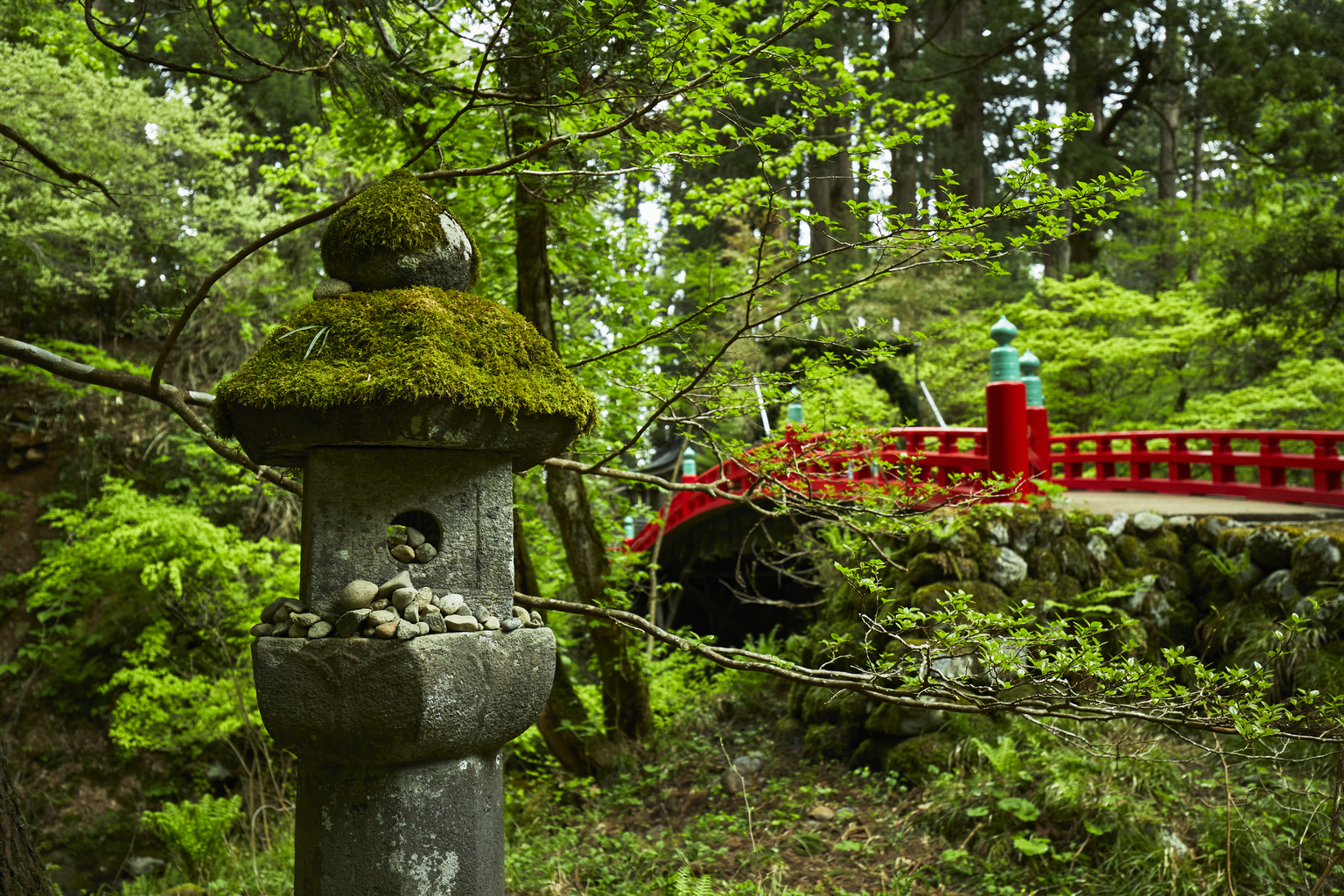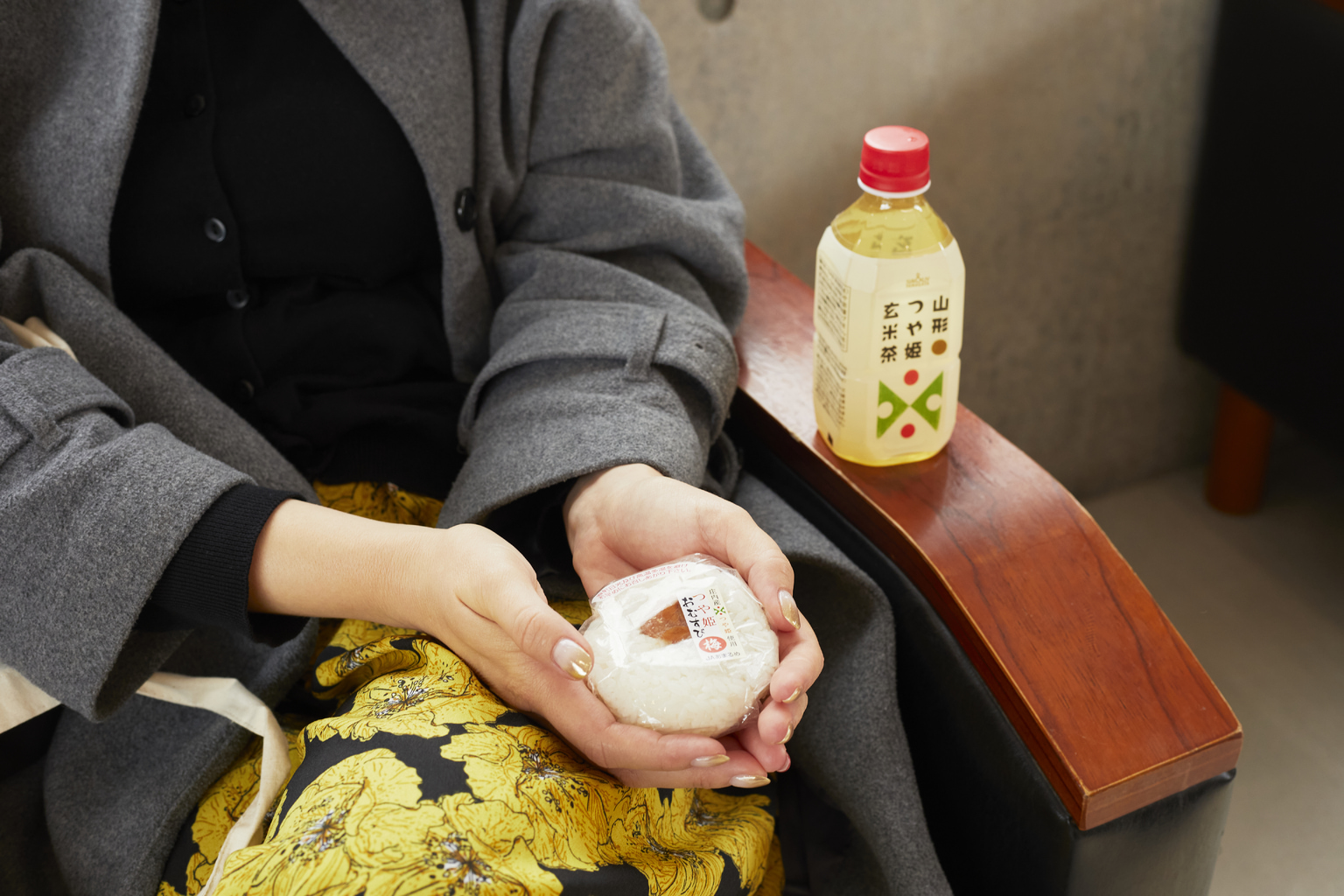Over 1,400 years ago, Prince Hachiko fled Nara, fearing for his life. His father, Emperor Sushun, had just been assassinated and as son and heir, Prince Hachiko was a likely next target. At the advice of his cousin Prince Shotoku he escaped north, hugging the Sea of Japan coastline. After a brief detour via Sado Island, he reached the mainland again. There, a three-legged crow — an auspicious symbol — guided him to the Dewa Province (modern-day Yamagata Prefecture) and, finally, to the top of Mount Haguro.
Scaling Mount Haguro the Modern Way
Almost a millennium and a half later, my colleague Ryoko and I ascend Mount Haguro’s diminutive 414 meters the easy way: by bus. We have some time to kill before an interview with a shrine priest in the afternoon and though I’ve visited the mountain before, I’ve never attempted its Michelin Green Guide-starred stairs. Mount Haguro is the only peak of the three Dewa Sanzan mountains that is accessible year-round, but even in mid-May clouds of silver vapor escape our lips as we speak. Patches of snow linger in the crevices of cedar tree roots, still hidden from the early summer sun. We slip on the jackets we brought but didn’t think we would need, and I curse myself for not bringing gloves.
The parking lot is void of life, the Golden Week crowds already a distant memory. The bus driver waves us off with a smile, but not before warning us that the 2,446 stone steps will be slippery from the previous night’s rainfall. We make a detour before setting off and enter one of the few shops that are open. It’s empty. A woman appears from the back and as she wraps our hand embroidered Shonai sashiko pouches, she repeats the warning about the treacherous steps. Our walk down the stairs is supposed to be easy, but now we’re not so sure.
Dewa Sanzan: Past, Present and Future
After Prince Hachiko arrived at Mount Haguro, he established the Dewa Sanzan, or the Three Mountains of Dewa. It’s one of Japan’s oldest regions of mountain worship and encompasses the three sacred mountains Mount Haguro, Mount Gassan and Mount Yudono. Prince Hachiko devoted his life to ascetic religious pursuits at Mount Haguro, eventually reaching enlightenment and curing illnesses.
In a traditional Dewa Sanzan pilgrimage, ascetics climb Mount Haguro, Mount Gassan, Mount Yudono and then exit via Mount Haguro again. Each mountain represents a part of the life cycle, with Mount Haguro symbolizing the present day or the now. Mount Gassan — the tallest of the trio — takes pilgrims to the past. The final peak Mount Yudono represents rebirth, or the future. To complete the full pilgrimage, ascetics make their way down Mount Haguro’s 2,446 stone steps to return to the world of the present as reborn individuals.
We — being lazy and short on time — are taking the shortest of shortcuts by only walking the final stretch. Still, we stop to pay our respects at Sanjin Gosaiden, a shrine that serves as a placeholder for the three mountains if you are unable to visit them all. I also visit Hachiko Shrine, dedicated to the prince who founded this sacred site. I drop a few coins in the offering box and bow twice. As I put my hands together, a warmth spreads over me from the crown of my head down to the back of my legs. I clap twice and bow once more before turning around, blinded by the light. Streams of sunlight fill the gaps between the towering cedar trees and warm my skin. A blessing? Or just good timing. I’m not sure which, but I take it as a good sign for our journey ahead.
Mount Haguro: 2,446 Steps Later
Ryoko and I are barely a third of the way down when I realize that the bus driver and the woman at the sashiko shop weren’t exaggerating. The uneven slabs of stone are slick with rainwater, creating slippery deathtraps. Still, we press on. The cedar trees, straight as arrows, loom over us in silence, our only soundtrack the occasional plops of water hitting leaves and rocks.
I imagine what Edo era poet Matsuo Basho felt when he climbed Mount Haguro over 300 years ago. He scaled it after visiting Mount Haguro’s five-storied pagoda on his way to Saikan — then known as the temple Kezoin — for a shojin ryori vegetarian supper. There is a memorial dedicated to him along the 1.7-kilometer path, but we do not stop. Cool droplets slither down the back of my neck and from my hairline and I lose any sense of romanticism as the sweat — or the humidity, I’m not sure which — seeps into my clothes. I assume I should feel some level of shame for being this easily discouraged, but I don’t get out much these days.
Near the rustic Ninosaka Chaya teahouse — about two-thirds of the way down, we encounter joggers nimbly bouncing up the trail and an older couple who ask us as they mop their brows, “It’s not much further up now, is it?”
We reluctantly tell them the worst is yet to come. The steps nearest the top are the steepest. Seeing them struggle upwards, we finally feel more confident in our slow descent down Mount Haguro.
Almost There: The Mysterious Stone Carvings
By the time we reach the bottom, we are both wheezing and our calves move with painful resistance. Thanks, sedentary lifestyle. A man in his eighties sporting a wooden cane and white rubber boots — the kind you’d normally see on a fishmonger — beckons us over. “Come here,” he asks and shuffles forward.
Ryoko and I glance at each other, then plod after. We’re too tired to argue. We pass Tohoku’s oldest pagoda, the five-storied pagoda of Mount Haguro. Its impressive 29-meter height is dwarfed by the surrounding cedar trees. We will return, after our self-appointed guide has finished his detour. As we walk, he tells us he climbs Mount Haguro — both up and down — on a weekly basis. Suddenly the hit our pride takes hurts more than our sore muscles. In a thick Shonai dialect, our new guide explains that there are a total of 33 carved stone slabs on the trail to the summit. He points at a blank-looking rock by his feet and asks us to pour water there. I uncork my water bottle and splash some on it. Soon, the outline of a gourd appears on the rock. “They are carvings of auspicious symbols. Find all, and good fortune awaits,” he says.
He pauses. “I’ve yet to do so myself,” he admits.
With his help, we find one more. And though we risk not having our dreams come true, we decide not to go back to find the rest. Another time, perhaps.
Tips for Visiting Mount Haguro
- A bus service can take you from Tsuruoka Station straight to the summit of Mount Haguro. However, departures are limited.
- Making a return trip to Mount Haguro or stopping by other areas in the city? Buy a one-day bus pass to save some cash. You can buy it on the bus.
- The walk up (or down) the 2,446 steps takes about 60 to 90 minutes. Though it is relatively easy, the steps are uneven and weather conditions can make it more challenging.
- There are two public toilets: one inside the waiting room next to the Zuishinmon Gate bus stop (near the five-storied pagoda) and one behind the Haguro Sancho bus stop at the summit. Both are free, but the facility at the summit encourages donations to support maintenance costs. There is also a restroom inside the Ninosaka Chaya teahouse (about two-thirds of the way down the stone staircase), but it is reserved for customers only.
- While you’re in the area, stop by Shonai Shrine and other nearby destinations.
- Looking for a place to stay? Try the luxurious Shonai Hotel Suiden Terrasse, designed by Shigeru Ban.
Photos by Ryoko Ogawa

